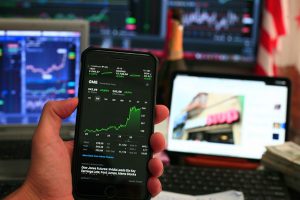
What is a Limit Order in Stock: An In-Depth Exploration
Updated Jan 23, 2024
Limit orders are like setting a GPS for your stock trades: you decide the destination price, and your order takes the journey only when the market hits your set coordinates. This precision tool is favoured by traders who prefer to navigate the stock market with meticulous control over their entry and exit points.
Imagine you’re eyeing a stock currently priced at $50, but you believe it’s a steal at $45. By placing a limit order, you instruct your broker to snap up the stock only if it dips to your target price or lower. This way, you’re not caught off guard by sudden spikes or drops; you’ve set your financial sails for smooth trading seas.
Understanding the bid and ask prices is crucial when setting a limit order. The bid price is what buyers are willing to pay, and the ask price is what sellers are willing to accept. Your limit order plays matchmaker, waiting for the right bid or ask to meet your specified price within this spread.
In volatile markets, where stock prices can swing wildly like a pendulum, limit orders are your anchor. They ensure you don’t overpay in a surge or sell for less in a slump. However, it’s a delicate balance: set your limit too far from the current price, and you might miss the boat entirely if the market doesn’t swing your way.
For those who like to trade on the latest news or earnings reports, limit orders can be placed even when the market is taking a nap. Set your price after hours, and if the market wakes up on the right side of the bed, your order will be waiting to greet it.
In essence, limit orders are about empowerment. They give you the reins, allowing you to trade on your terms. Whether you’re a day trader with an eye for timing or a long-term investor waiting for the perfect price, limit orders can help you buy and sell confidently, knowing you’ve taken a calculated approach to your financial strategy.
Market Orders: The Quick and Decisive Approach
On the other side of the trading spectrum are market orders. These are the sprinters of the stock order world, prioritizing speed over price precision. When you place a market order, you’re telling your broker, “Get me in (or out) now, and don’t fuss about the price!”
Market orders are the go-to for traders who value immediacy. If a stock moves faster than a high-speed train and you want on board, a market order is your ticket. It’s executed at the next available price, which means you could be surprised if the market is particularly jumpy.
The trade-off with market orders is the potential for slippage. This is when the price you pay (or receive) slips away from the last seen price due to rapid market movements. It’s the price you pay for the urgency of a market order.
While market orders can be a bit more costly due to higher broker fees, they’re the straightforward choice for those who prefer the certainty of execution over the price uncertainty. They’re a powerful tool when the market tide is with you, but they require a steady hand and a watchful eye on the market waves.
The Takeaway
Whether you choose the precision of a limit order or the speed of a market order, understanding these tools is critical to navigating the stock market’s complex waters. Each order type offers different advantages and requires a strategy tailored to your trading style and market conditions. By mastering these orders, you’re not just trading stocks but strategically positioning yourself in the vast ocean of financial opportunity.
Any time a trader seeks to execute a market order, this means the trader is willing to buy at the asking price or sell at the bid price. Thus, the person executing a market order is immediately giving up the bid-ask spread.
Amplifying Investment Gains: Harnessing the Potential of Limit Orders at The Tactical Investor
At The Tactical Investor, our primary goal is to optimize your investment returns by ensuring you buy at the most advantageous prices. Our key strategy to achieve this involves the extensive use of limit orders – a controlled approach to stock and ETF purchases that offers precision and can significantly enhance your financial success.
Let’s illustrate this with an example. Say you’ve set your sights on the ETF IBB (iShares Nasdaq Biotechnology) and are ready to invest. However, you’ve done your homework and decided that the ideal price range for purchasing this ETF lies between $109 and $111. In this case, you could place a limit order for 100 shares set at $111 or better. This means you’re instructing your broker to execute the purchase only at $111 per share or less, ensuring you’re not paying above your target price.
Suppose the market swings in your favour and the ETF price dips below your limit. In that case, you could pay less than $111 per share, thereby maximizing your investment potential. This strategy safeguards you from overpaying, particularly in volatile markets where prices can fluctuate rapidly.
By deploying limit orders, you assert control over the price parameters of your investments. This proactive strategy safeguards your resources and positions you to capitalize on market opportunities. At The Tactical Investor, we strongly advocate the power of limit orders. We consider them an invaluable tool for discerning investors aiming to maximize their financial outcomes in the complex landscape of stock and ETF trading.
Stop limit order
A stop limit order is a type of order used in trading that combines the features of a stop order and a limit order. It is designed to help traders limit potential losses and control the execution price of their trades.
Here’s how a stop-limit order works:
1. Stop Price: The trader sets a stop price at which the stop limit order will be triggered.
2. Triggering the Limit Order: When the stock’s price reaches or surpasses the stop price, the stop limit order is triggered.
3. Limit Price: Along with the stop price, the trader also sets a limit price. They are willing to buy or sell the stock at this maximum price.
4. Becoming a Limit Order: Once the stop price is reached, the stop limit order becomes a limit order. It will only be executed at the specified limit price or better.
It’s important to note that while a stop limit order guarantees the execution price, it does not guarantee the order will be filled. The order may remain unfilled if the stock’s price does not reach the limit price.
Traders often use stop-limit orders to manage risk and protect their positions. By setting a stop price, they can automatically trigger a limit order to buy or sell a stock if it starts moving in an unfavourable direction. This allows them to define their maximum acceptable loss or target a specific entry or exit point.
Please remember that trading strategies and order types can vary, and it’s always a good idea to consult with a financial professional or do thorough research before making any trading decisions.
End of Day Stop?
An end-of-day stop is a strategy used in trading where a trader sets a specific price level at which they will exit a trade if the stock closes at or below that price. It is similar to a mental stop, as it is not an automatic order but a guideline for the trader to decide.
For example, you are trading an IBB stock and set an end-of-day stop at $81.00. You will consider exiting the trade if the stock closes at $81.00 or lower. Once the stop is triggered, you can enter a limit order to sell IBB at $81.00 or better.
If you are in a hurry to exit the position, you could also consider entering a GTC (Good ‘Til Canceled) limit sell order to sell at $80.50 or better. This means the order will remain active until you fill it out or cancel it.
It’s important to note that while setting an end-of-day stop can help protect against potential losses, it’s also possible for stocks to trend upward, allowing you to close the position at a better price than the stop price. Therefore, it’s essential to consider the specific circumstances and market conditions when using this strategy.
Duration of an order
The duration of an order can vary depending on the platform or brokerage you are using to place the order. Generally, when placing an order, you can specify the duration for which the order will remain active. Here are some standard order durations:
1. Good ‘Til Canceled (GTC): This order remains active until it is either filled or cancelled by the trader. GTC orders can remain open for an extended period, potentially even indefinitely, until the desired conditions are met.
2. Day Order: A day order is active only for the trading day it is placed. If the order is not filled by the end of the trading day, it will be automatically cancelled.
3. Immediate or Cancel (IOC): An IOC order is designed to be executed immediately and in its entirety. Any unfilled portion is cancelled if the order cannot be filled immediately.
4. Fill or Kill (FOK): A FOK order is similar to an IOC order but must be filled in its entirety immediately. If the order cannot be filled, it is cancelled.
5. Good ‘Til Date (GTD): Some platforms allow you to specify a specific date for the order to remain active. After that date, the order will be automatically cancelled.
It’s important to note that the availability of these order durations may vary depending on the platform or brokerage you are using. It’s recommended to check with your specific forum or brokerage for the available order durations and their particular terms and conditions.
Virtual Stock Trading Accounts
If you’re interested in paper trading, you can utilize one of the sources listed below.
Investopedia Virtual Stock Trading Account
Delve into Captivating Chronicles

The Best Turkish Food in Istanbul: Exploring Culinary Delights

Maximizing Gains: Mastering Market Sentiment Indicators

How to Achieve Financial Goals: The Midas Touch for Your Financial Dreams

Sophisticated Strategies for US Dollar Index Investing: Elevate Your Forex Game

How much has the stock market dropped in 2023?

Visionary Views: How to Achieve Financial Freedom Before 40

A Major Problem with ESOPs is That Employees Can Lose Big

The Sophisticated Guide to Cryptocurrency Investing for Dummies PDF

Considering the Impact of Inflation, Why Is Investing Important for Long-Term Financial Stability?

What the NASDAQ Composite is Trading at in Today’s Market

What Is Contrarian Investing Unleashing Creative Perspectives

ETF Newsletter: Customized Options for Astute Investors

ETF Service Providers: In-House Options for the Tactical Investor

Fearlessly Trade Your Way to Financial Freedom

Unlocking Radiance: Hemp Benefits for Skin Illumination
Tactical Investor Stock & Option Selection Process
Important Info To Read Before Getting into Options
How to Purchase Options on Stocks We have not issued any plays on


